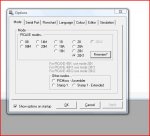I thought I was making progress but I've gone to the start. I've learnt by my mistakes but they seem to have returned regardless. I tried to load a new mini test program to try something else and it worked. I tried 3rd test program nothing happened. So I went back to the beginning and tried from there - nothing. I've tried new batteries, changed the LED's, changed resistors, checked all wiring with my meter, both resistance and voltage, all connections 3 times, all seemed to be all right. Now I know I'm new at this (still trying to get used to programming), followed the book step by step about putting a new program in the 08M chip but I'm not getting anywhere.
I must have messed it up with programming because everything else checks out. Any body got anysuggestions? http://www.picaxeforum.co.uk/images/icons/icon9.gif
Unhappy
I must have messed it up with programming because everything else checks out. Any body got anysuggestions? http://www.picaxeforum.co.uk/images/icons/icon9.gif
Unhappy

